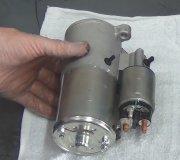Three of my top students were girls. The guys had a lot of respect for them. Also, a lot of guys are clueless about cars today, so don't feel discouraged.
The battery test is performed by some auto parts stores for free, but it's just as easy for you to start the testing yourself. You need a digital volt / ohm / amp meter. Harbor Freight Tools has a perfectly acceptable meter for less than ten bucks. You can find them at Walmart, Radio Shack, Sears, and any hardware store and auto parts store, but you'll pay for features you don't need. "Auto-ranging" is one feature to avoid. Also, the real expensive ones, like the guys on the tool trucks sell, do way more things than you need. Even after over 35 years in tv / vcr repair, I don't use those features.
Most digital meters use scales of "2", meaning depending on which scale you select, they will read from "0" to 2 volts, or "0" to 20 volts, or "0" to 200 volts. You won't hurt the meter by selecting the wrong scale. If you try to measure a 12 volt battery on the 2 volt scale, the meter will just display an "over-range" indication. That is different for each brand, but it's usually something like "OL" or "---". If you use the 200 volt scale, you'll lose one decimal place of accuracy so your battery will read "12 volts". You want the 20 volt scale because it will give you one more decimal place. We want to read your battery voltage to the tenth of a volt.
A fully-charged battery will read 12.6 volts. A good battery that's run down will read close to 12.2 volts. If it has a shorted cell, it will be near 11 volts or less.
To measure the voltage, just touch one meter probe to each battery post. If you reverse the positive and negative probes, the display will just show a minus sign, but the number will still be accurate.
These voltage tests only indicate the state of charge and if the battery is capable of supplying the necessary voltage, which is electrical pressure. You need a professional load tester to test the other characteristic of the battery. That is the amount of current, or electrical flow, it can deliver. If you find the voltage indicates the battery has a shorted cell, there's no point in going any further. Replace the battery. If it's just run down, use a home battery charger to charge it at a slow rate for about an hour, then test the voltage again. For a run-down battery, we have to figure out what caused that. Most commonly the alternator stopped recharging it while you were driving. Chrysler has always had a real easy system to test and repair. We'll cover that if necessary.
To tell if the charging system is working, you measure battery voltage again, just like before, but with the engine running. It must be between 13.75 and 14.75 volts. If it is low, there's a couple of quick tests that will tell us where to go next.
Monday, April 14th, 2014 AT 11:46 AM



